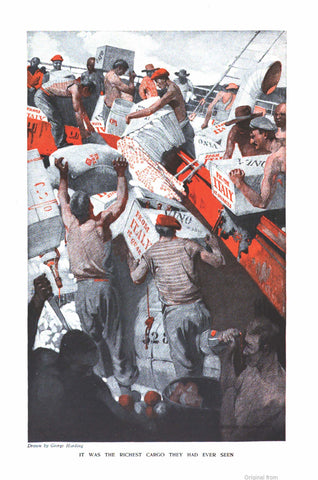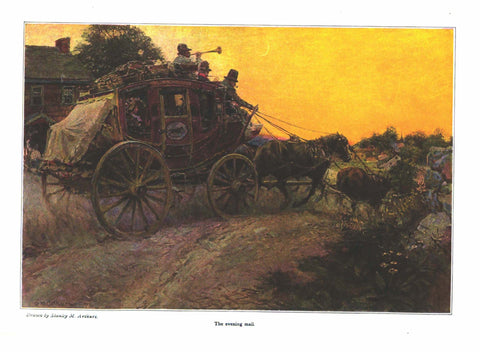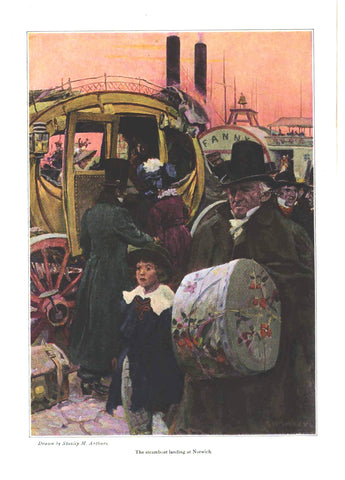Louis John Rhead cover illustration for The Ladies' Home Journal (1895): a beautifully framed antique
$295.00
Cover: The Ladies' Home Journal
Girl in Grape Arbor
Unsigned - possibly by Louis John Rhead
October 1895 Issue
IMAGE INFORMATION
Image Size: H 16.375” x W 11.375”
Matted & Framed: H 22.375” x W 17.375”
Framed Price: $295.00
Packaging and shipping approximately $26.00
A poster craze swept through the nation’s art and publishing communities after a poster show was staged at The Grolier Club of New York in November 1890.
“Audiences were impressed,” Roberta Wong reports, “by ‘the colorful closets of Cheret and Grasset which outsheath the few realistic prints by American lithographers, particularly [those of] Matt Morgan.’” [Reference: https://edwardpenfield.com/biography/the-grolier-exhibit-1890/.] The editor of the Edward Penfield website adds that Posterism arrived in America in the late 1880s. “From 1889 to 1893,” she continues, poster “designs for Harper’s Bazar, Harper’s Monthly, St. Nicholas and The Century became quite popular” and “increased sales for each of the magazines.” [see: https://edwardpenfield.com/chronology/.]
William Bradley was an early leader in advancing the new style. Edward Penfield was perhaps a more important pioneer since he held the post of Art Director at Harper & Brothers Publishers during the 1890s, and was able to highlight the art form on the covers of their popular weekly and monthly magazines. EP’s first “poster” cover appeared on the April issue of Harper’s Monthly Magazine. We can assume EP’s image was well-received because over the next eight years he created several dozen more poster designed covers for the magazine.
The Ladies’ Home Journal was as popular as Harper’s Monthly Magazine thanks to the genius of its Editor, Edward Bok. Bok had taken LHJ’s helm in 1899 when its founder, Louisa Knapp Curtis, retired. In 1896, he secured his place in the upper echelon of the Curtis publishing empire by marrying Mary Louise Curtis, the only child of the publisher,
The conservative Bok kept abreast of the trends that shaped the tastes and buying habits of his audience, but he took his time before risking the prestige of his influential publication by endorsing styles that might fizzle out. Trends in art fell into this category. Those who take time to review the LHJ’s cover images in the first half of the 1890s will find that Bok was no pacesetter. He played it safe with scenes featuring trim, nicely dressed upper crust women doing things one expects to see nicely dressed upper crust women doing. These scenes were binary photolithographs drawn by trustworthy figurists like Alice Barber Stephens, Frank O. Smith, Albert Lynch, and W. T. Smedley. Now and then one finds a Gibson Girl. In July of 1896, Box dared to publish one of Maxfield Parrish’s symmetrical cartoons. But in the first half of the 1890s, the only concession to the artist design one finds on Ladies Home Journal covers are an occasional decorative board.
This record makes the cover of the magazine’s October 1895 issue notable—and valuable. Not only was this cover image the magazine’s first full-blown poster design, it was on the technological cutting edge, being a three-color chromolithograph with orange, blue, and black laid on a light cream white substrate. Unable to abandon protocol entirely, the center of the decorative arbor is occupied by another of the LHJ’s mandatory ingenues.
Surprisingly, the beautifully drawn image is not signed. Nor is the artist named in the magazine’s masthead. The likelihood is, however, that the artist was Louis John Rhead. In 1895, the English-born artist was the Art Director for D. Appleton of New York. He had come to America in 1883. As a boy, he had trained with his artist-father. But in 1872, his father had sent him to Paris where he was schooled in the classical style under Gustave Boulanger.
In New York, LJR encountered the work of graphic designer Eugène Grasset, most likely at the Grolier Club’s 1890 exhibition. For the next decade, he was a leading practitioner of a poster-like style that merged Grasset’s graphic design with the detail and composition he had absorbed during his classical training. No doubt it was this combination that made Rhead’s posters appealing to Bok.








